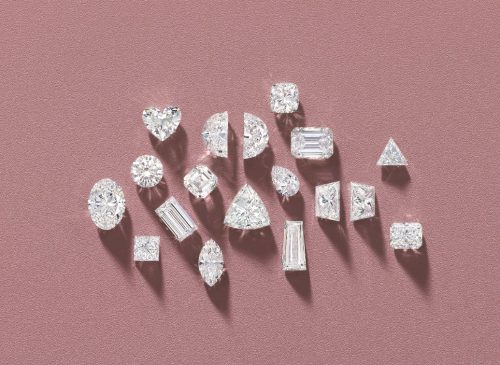Intro to VVS Diamonds
In your search for the perfect engagement ring in Winnipeg, you have probably heard the term VVS diamonds come up a few times. This term refers to a diamond’s clarity and stands for Very Very Slightly Included. Clarity is an aspect of the famous 4 C’s of diamond grading which refers to the diamond’s visual appearance and the presence of any blemishes or impurities. A grading of VVS means the diamond has very minute inclusions, difficult to notice even under high-powered magnification.
Hence, VVS diamonds are commonly known as “eye-clean,” indicating that the naked eye cannot perceive any inclusions or blemishes. On the clarity grading scale, VVS diamonds sit just one step below the coveted internally flawless (FL) diamonds. Diamonds with minimal or no clarity characteristics are exceedingly scarce, and VVS diamonds belong to this highly prized category.
Let’s take a closer look at diamond clarity to better understand VVS diamonds.
Diamond Clarity and Inclusions
To understand VVS diamonds, we must first grasp the concept of diamond clarity and inclusions. Clarity refers to the presence of internal or external characteristics, known as inclusions and blemishes, respectively. These characteristics are formed during the diamond’s natural growth process deep within the Earth’s crust. Inclusions can also be formed during the making of lab-grown diamonds as well. While most diamonds contain some form of inclusion, the rarity lies in finding diamonds with minimal or no visible inclusions.
The Diamond Clarity Scale
The Gemological Institute of America (GIA) developed the internationally recognized diamond clarity scale, which grades diamonds based on their inclusions. The scale ranges from Flawless (FL) to Included (I), with VVS occupying a prominent position within this grading system. VVS diamonds are further divided into two categories: VVS1 and VVS2.
Characteristics of VVS Diamonds
VVS diamonds possess exceptional clarity, with inclusions that are extremely difficult to detect even under 10x magnification. These inclusions are typically tiny, often invisible to the naked eye, and do not impact the diamond’s overall beauty or structural integrity. The internal flaws within VVS diamonds are typically minute pinpoints, crystals, or feathers that require an expert examination to identify.
VVS1 Vs. VVS2
While both VVS1 and VVS2 diamonds fall under the VVS category, there are subtle distinctions between them. VVS1 diamonds tend to have slightly fewer and smaller inclusions than VVS2 diamonds, making them marginally more valuable. However, the differences between the two grades are often imperceptible to the naked eye.
What’s the difference between VVS and VS diamonds?
VS diamonds are classified as “Very Slightly Included,” indicating the presence of minor inclusions that may range from challenging to somewhat noticeable under 10x magnification. While various types of inclusions can be found in VS diamonds, they are typically very small in relation to the diamond’s size in order to receive this grade.
VS diamonds occupy a category one grade below VVS diamonds. Within the VS category, there are two sub-grades: VS1 and VS2. The primary distinction between them lies in the visibility of the inclusions. VS1 inclusions are generally difficult to perceive, while VS2 inclusions may be somewhat more noticeable. Although we are comparing VVS and VS diamonds, it’s important to note that both categories are likely to represent eye-clean diamonds, as the lower VS clarity grades are typically not visible to the naked eye.
VVS diamonds in pop culture
One factor which has contributed to the popularity of VVS diamonds, is various references in pop culture. Various hop hop artists and celebrities often give mention to this sought after diamond quality characteristic.
What to look for when purchasing VVS Diamonds
When shopping for a diamond, its important to consider all of the quality variables. While VVS diamonds possess an exceptional clarity grade, its also very important to find the highest quality cut possible. The cut refers to the various angles and proportions which contribute towards it’s ability to reflect light. For this reason we often consider the cut to be the most important factors when buying a diamond and we do not recommend sacrificing cut quality for carat weight, color, or clarity.
When it comes to the clarity grade, always aim for a diamond which is totally eye clean, without the presence of visible blemishes. While VVS diamonds are a pretty good guarantee in this regard, we also find great diamonds with SI clarity. Despite being slightly lower in clarity grade, these diamonds can also be eye clean and offer exceptional value. During your consultation with our expert team we can help you make the right choice for your budget and style.
Alternative choices to VVS Diamonds
While VVS diamonds offer unparalleled clarity, they may not be the ideal choice for everyone. Depending on your preferences and budget, you may explore alternative options such as VS (Very Slightly Included) or SI (Slightly Included) diamonds. These grades offer excellent value while still maintaining a high level of visual appeal.
Conclusion
VS diamonds represent the epitome of clarity and rarity in the world of diamonds. Their exceptional clarity, coupled with their natural beauty, makes them highly sought after by diamond buyers and those shopping for engagement rings. However, it is essential to consider your personal preferences, budget, and the overall quality of the diamond before making a purchase decision. Whether you choose a VVS diamond or an alternative grade, always ensure you receive proper certification and buy from a trusted source. With this knowledge, you can confidently navigate the world of VVS diamonds and appreciate their extraordinary beauty and value.
Are you looking for VVS diamonds in Winnipeg?
Book your appointment with Omori Diamonds now!

